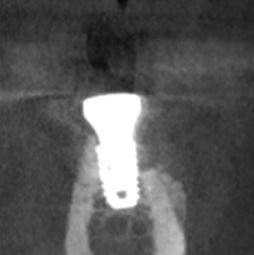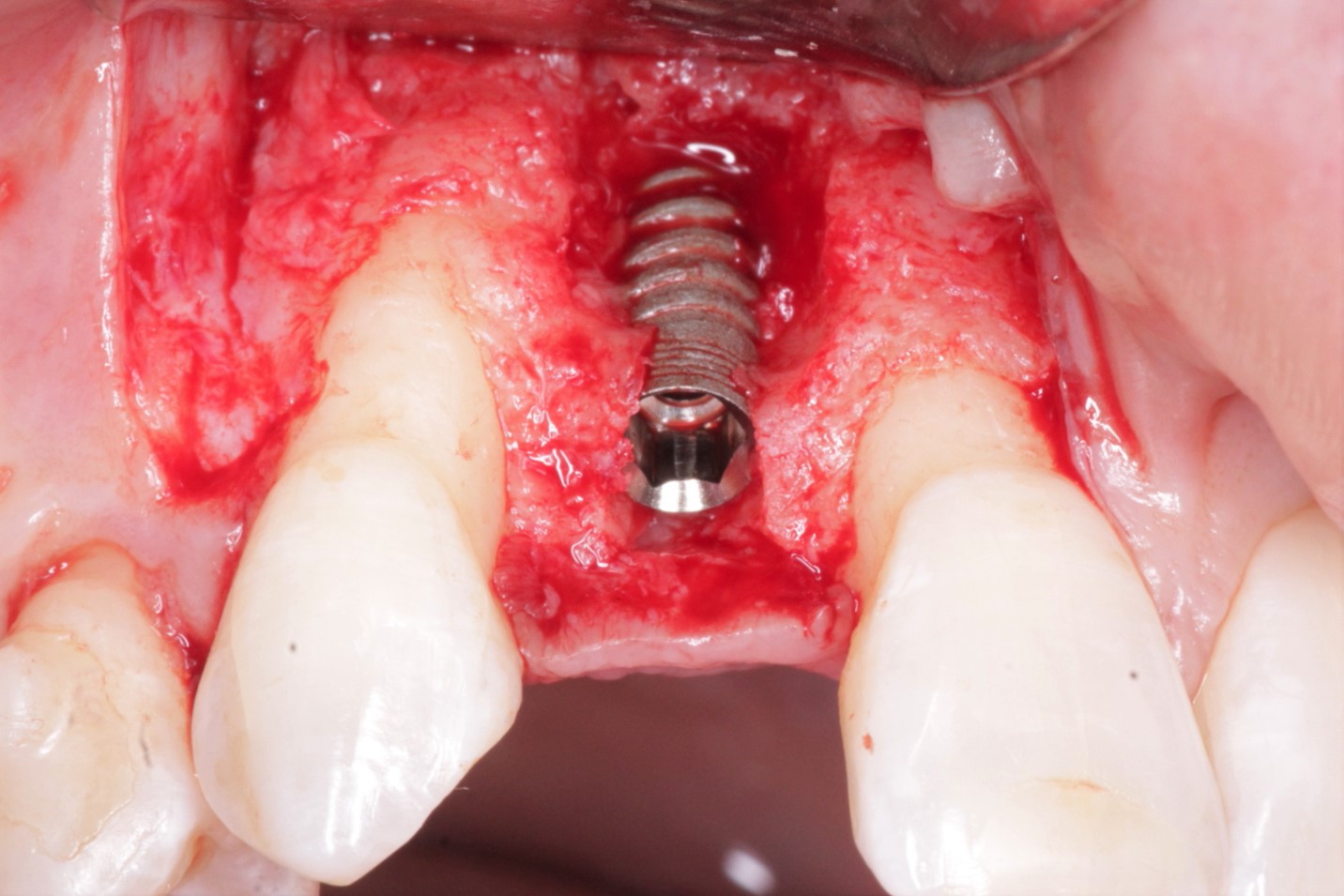Dental Implants in Infected Sites
Dr. P. from New York asks:
I have been getting some mixed messages about how to deal with dental implant sites that have frank signs of infection. I place and restore my dental implants. In the past, when I had to extract a tooth with a chronic periapical infection, I would wait about 3 months before placing the dental implant. Am I being too conservative? If I extract the tooth, thoroughly clean out the socket and granulation tissue and prescribe a systemic antibiotic, can I place the dental implant immediately without waiting for the area to heal over? I would like to find out what others are doing about this.
13 Comments on Dental Implants in Infected Sites
New comments are currently closed for this post.
Prof.Samir Koheil
2/4/2007
It is possible do immediate replacement in infected socket provided that you prescribed the appropriate antibiotic that will extend one week after surgery and to extend the implant deeper in a sound area. Other wise you can do it after one week not three months. Curretage is essential and postoperative antibiotic.I follow this way and succesfull.
Alejandro Berg
2/6/2007
If you make a correct debridement, under antibiotic protection and you can get a good initial stability then you can place an implant , if one of those is a no... wait 10 days and then go.
Dr John Berne
2/6/2007
You are playing with fire if you place implants in an infected site and are relying on antibiotics to get you through.
There are 2 issues here-firstly there is an increased risk of implant failure, and secondly there is the question of overuse and abuse of antibiotics.
If a tooth is infected and requires removal then its removal usually results in clearing of the infection without antibiotics. The site for an implant then becomes infection free and no antibiotic will usually be required for later implant placement.To risk allergic reactions and drug resistance to antibiotics purely to expedite implant placement is poor practice.
Marwan Assaf
2/6/2007
I recently placed an immediate implant following extraction of tooth #7. Following a thorogh debridement of granulation tissue, a large perforation of the buccal plate around the apical area was present. I placed a 3i Osseotite NT implant achieving excellent stability. The implant was showing thru the area of fenestration. I covered the area with DFDBA bone graft and a collagen membrane. Prescribed antibiotics for 10 days. I exposed the implant 6 months later and excellent integration and bone regeneration was noted. Even the cover screw was covered with bone.
Andrew Kelly
2/6/2007
My experience is that extracting the tooth and placing the implant is the the best way to go. I place the patient on antibiotics for one week prior and three day after implant placement and extracton. I also put one carpule of arestin in the osteotomy. I have a 98% sucess rate with this method. Also the patient gets the tooth in 3-4 months instead of 6-8 months and avoids the second surgery to place the implant, it is win win.
Kevin Neshat
2/7/2007
I have been extracting teeth that are even acutely infected with mild purulent drainage and placing MFDB for over 4 years. I cannot recall the last complication I had with this procedure (over 350 per year, cant give a % of acutely infected ones). As far as placement of an implant in the site; I place implants in chronically infected sockets routinely. However, I have had several bad experiences with implants in acutely infected sites. Therefore, I do not place them now. I give every pt, 600mg Cleocin 1 hour pre-op and 5 days po. As well as Medrol, Peridiex rinse. I place collaplug and 3 gut and glue over every socket. I hope that this helps.
Alan Bream DDS
2/7/2007
There is no doubt that an implant can be successfully placed into an infected extraction socket. Careful tooth removal is needed in order not to damage the boney socket. The buccal plate is usually the most vunerable to fracture. I like to use Luxators by Schumacker for an "atraumatic"
tooth removal.I will most all the time lay a buccal flap so I can examine the buccal plate and upon closing use a releasing incision to gain a fluid tight post-op seal. A large round bur along with a sharpe curette will get you to solid white, bleedy bone. Three mm of apical bone is ideal.
Proper alinement in the socket,mesial/distal, buccal/lingual,and occlusal/apical are critical for an esthetic restoration. Bone graft is often needed to fill between the implant and the boney socket. I often fine the need for a "sinus lift" procedure in the maxilliary arch at which time it is critical to obtain a tight closure. I will follow with antibiotics, Peridex rinse, pain meds, and ice the rest of the day. The releasing incision has a tendency to bleed into the tissue so would show up as brusing always advise patient. I have found two minutes of firm finger pressure to be a big help in reducing this tendency to bruse.
SFOMS
2/8/2007
Dr. Neshat,
If you are mentioning Medrol in your comment as in a Medrol dose pack, if so, for what indication are you giving the patient oral steroids for an infected site-implant case?
Dr.s.p.
3/13/2007
i have put 3 implants in the region of lower left 1st and 2ndpremolar, and the 1st molar region on sunday. but on seeing the opg today i find that my implant at the region of 1st molar has encroached on the roots of the lower canine by a good 2 mm. what should i do, should i remove the implant and try to replace it in a different angle or what ? i am very confused ? kindly suggest and share with me your experience please
Tommaso Grosso
11/1/2007
There is an interesting article about replacement of teeth exhibiting periapical pathology by immediate implants in Clin Oral Impl Research 2006 (Siegenthaler DW.)Curretage is essential and postoperative antibiotic. You must also respect the criteria to obtain success in post-extractive implants such as good primary stability. In the last year I placed 45 JDNow implants(JDentalCare srl)in fresh extraction sockets with periapical infection, with a survival rate of 97.8%.
DR. AKHIL
9/21/2009
I HAVE BEEN CHECKING SURVIVAL RATE FOR DENTAL IMPLANT PLACED IN FRESH DEBRIDED INFECTED EXTRACTION SOCKET IN OUR INSTITUTE. RESULT WAS GOOD ABOUT 95% I WANT TO FOLLOW UP THESE PATIENT FOR EARLY SUCESS RATE THAT IS AFTER 1 YR OF LOADING WHAT CRITERIA AND NEED FOR STUDY SHOULD BE USED FOR THESE. PLEASE SUGGEST FOR MY POST GRADUATION THESIS
Matt
11/3/2009
I had a tooth extraction and double implants for the extracted tooth and the one adjacent (#11 & 12). I developed an infection that would not go away. The surgeon had to re-open the area yesterday to take a look. He cleaned it up and re-did the the bone grafting. This time he used a titanium membrane with 2-screws to hold in place. He thought the original membrane was prone to infection. He did a heavier job of suturing it back together and gave me a lot of antibiotics (at least 2 more weeks). I want to know if this is normal. Are there any issues taking too many antibiotics. Should I change to a different antibiotics? Any expert advice is appreciated.
thanks,
Matt
Dr Saurabh Gupta
11/14/2011
Placement into sites associated with chronic periapical pathology has been considered a relative contraindication. However, data from animal research, human case reports and case series, and prospective studies showed similar success rates for implants placed into sites associated with chronic periapical pathology compared with implants placed in non pathologic or pristine sites.Following atraumatic extraction, curettage and proper debridement, under pre and post-antibiotic protection and if you can get a good initial stability then you can place an implant immediately after tooth extraction with some mild pathology(May be less then 3mm)

















